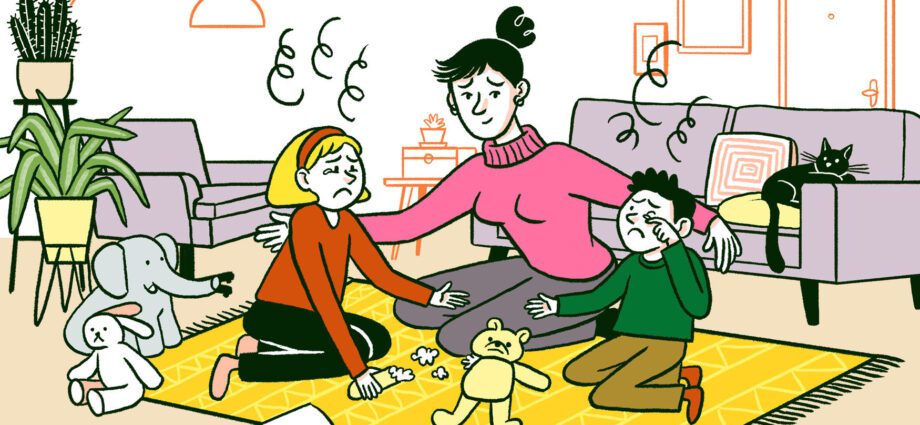Contents
Why children fight: how to reconcile children, advice from a psychologist
Not only boys, but also girls often pounce on each other with their fists. Together with the child psychologist-teacher Elena Abramova, we understand the source of the problem and look for ways to solve it.
Every time I learned about pregnancy, I thought: “Boy!” But on the 25th week, the ultrasound doctor said with a smile: “Girl!” and handed me the indisputable proof – a photo of my daughter.
Now I have two blond angels of two and five years old with huge brown eyes and long eyelashes. They can transform from cute young ladies into angry little furies in less than a second. There would be a reason … And the girls fight no worse than boys.
Two years of “hostilities”, fruitless attempts to understand why the older one hurts the younger one and vice versa, the regular divorce in the corners and the endless: “You can’t fight, you girls!” brought me to a psychologist. Before a child psychologist.
– When the elder touches the younger, this is a kind of experience for her. She already knows how to behave with you, with other people and things that surround her. But with such a small creature like a younger sister – no. And she checks: how will the little sister react? Therefore, he can take away the toy, and hit … Or do something else. You can endlessly come up with situations, how to separate them, and endlessly figure out who is right and who is not. For adults it is the same: here the traffic police arrive at the scene of the accident, and each driver tries to pull the blanket over himself. Children are more difficult to deal with. And this is useless …
“Make up, make up, make up …”
Oddly enough, but the most effective way of reconciliation are all the same little finger for little finger and the magic phrase: “Make up, make up, make up and don’t fight anymore …” And on the last phrase “Because we are friends!” – joyfully to embrace the fighters, allowing them to snuggle up to each other. After all, one more touch to mom and each other is a manifestation of reliability and protection. At this moment, with an exhalation, the negative mood is removed. I remember her from the time when I myself was at the same age as my daughter. And the psychologist recommends the same “mirilka”:
– It is enough to take hold of the little finger, strictly say: “We do not fight!” or “People don’t fight, people talk!” Because if you say, “Children don’t fight,” it turns out that adults can? Still, it’s better to say: people don’t fight. People agree: they say magic words. Here you have to try: “Say:” Give, please. ” If they still grumble and squeak, then just separate and grab the little finger. They play, and this “peace” with humor. And that’s all – the situation is smoothed out.
I checked the “peace” in the evening. The first battle ended with a score of 1: 0 in my mother’s favor. The girls made it up quickly.
But not for long.
– Mom, it hurts! She hugged me too much! – the eyes of the eldest daughter are already filled with tears, the youngest looks at her sister in confusion: “I hug you, why are you crying?”, And I am waiting for the inevitable second round of hostilities. And in such a case, the psychologist has advice: do not expect them to do what you want the first time.
– Any skill in behavior is formed. The fastest is acquired in 28 days, the longest can be acquired in a year. The habit must be developed. That is, everyone must follow the rules of conduct in your home every day. Children had a fight – firmly grab the hands of the fighter, turn him by the shoulders from the other person, and at this moment say again “People do not fight, people talk.” And then you can take the child’s palm in your hands and say: “The palms are stroking” – and stroke the child’s hand on the one he hit.
Why is it important to act with young children and talk less, persuade?
– You approach the problem like an adult. It `s naturally. An adult acts in a chain: “thinking, feeling, and only then action.” You first assess the situation, a feeling appears, and then you start doing something. For a child, everything is exactly the opposite. First, he acts (for example, hit his sister). Then he has a feeling (for example, fear or fear that they saw it), and only then he realizes that he will be punished (that is, the child begins to think). Therefore, no need to talk! Immediately respond to the child’s action with an action: remove his hand, stop the fight … Then turn on your feelings: gently, gently take his hand in yours and stroke the child’s hand on the sister he hit. Both sides of the conflict will have a pleasant feeling instead of aggression and irritability. And only then, continuing to stroke, say the code phrase: “People don’t fight! People agree. They do not hit with the palm, they stroke it with the palm. Then the child will remember.
Reconstructing oneself to fit the child’s behavior was not easy. Still, an adult “talk heart to heart” still takes its toll. But, acting on the advice of a psychologist, the number of fights between daughters was reduced by several times (to 1-2 per day instead of 6-7). The girls began to learn to negotiate. Life has become calmer.










